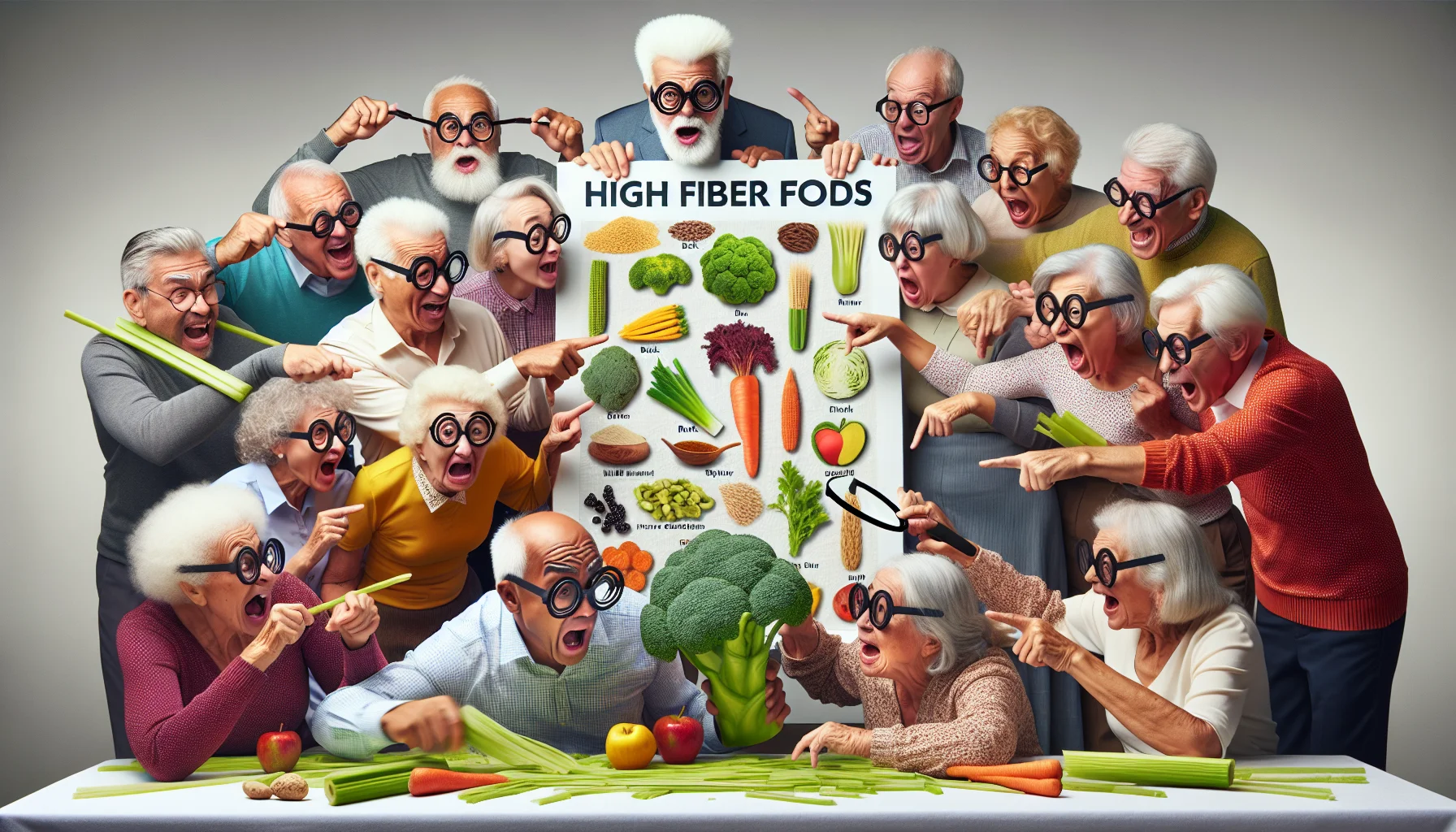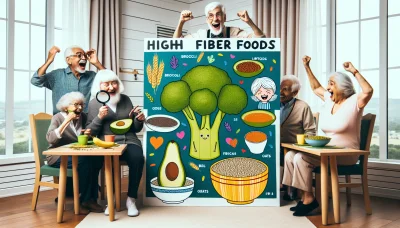Chart of high fiber foods Quiz
Test Your Knowledge
Question of
Understanding High Fiber Foods
Definition and Importance of Dietary Fiber
What is Dietary Fiber? Dietary fiber is the indigestible part of plant-based foods that passes through our digestive system mostly unchanged. It's a crucial component of a healthy diet, aiding in digestion and providing a sense of fullness.
Health Benefits of Fiber Consuming high fiber foods offers incredible benefits, including reduced risk of heart disease, lower cholesterol levels, and improved bowel movements. It's a powerhouse for maintaining overall health.
Daily Recommended Fiber Intake The daily recommended intake for adults is 25 grams for women and 38 grams for men. However, most people are not hitting these targets, which underscores the need to consciously include more fiber-rich foods in our diets.
Types of Dietary Fiber
Soluble vs. Insoluble Fiber Soluble fiber dissolves in water forming a gel-like substance that can help lower glucose levels and blood cholesterol. Insoluble fiber does not dissolve, thus adding bulk to the stool and preventing constipation.
Prebiotic Fiber and Gut Health Prebiotic fiber is a type of soluble fiber that feeds the beneficial gut bacteria, playing an essential role in digestive health. A healthy gut microbiome is linked to numerous health benefits beyond the digestive system.
Fiber in Weight Management High fiber foods are more filling, which can lead to reduced calorie intake and aid in weight management. Including fiber-rich options at meals can help you feel satiated longer, reducing the temptation for unnecessary snacking.
Identifying High Fiber Foods
Vegetables and Legumes Vegetables like broccoli, carrots, and legumes such as lentils and beans are excellent sources of both soluble and insoluble fibers. They should be staples in your diet if you're looking to increase your fiber intake.
- Veggies: Broccoli, Brussels sprouts, carrots
- Legumes: Lentils, black beans, chickpeas
- Tips:
- Incorporate a variety of colors to get different types of fibers.
- Add legumes to salads, soups, or as a main protein source.
- Eat vegetables raw or lightly steamed to preserve their fiber content.
Fruits and Nuts Fruits such as berries, apples with the skin on, oranges, and bananas are fantastic sources of dietary fiber. Nuts like almonds also contribute a significant amount of fiber along with healthy fats.
Whole Grains and Seeds Whole grains like oatmeal, quinoa, and brown rice contain more fiber than their refined counterparts. Seeds such as chia seeds and flaxseeds are not only high in fiber but also omega-3 fatty acids.
Incorporating High Fiber Foods into Your Diet
Creating a Balanced High Fiber Meal Plan
To create a balanced high fiber meal plan, start by integrating a variety of fiber-rich foods across all meals. This means including fruits, vegetables, legumes, and whole grains in your diet. The key is diversity, ensuring that you are not only getting fiber but also an array of nutrients.
Sample High Fiber Meal Ideas : Breakfast could be oatmeal topped with berries and chia seeds. For lunch, consider a quinoa salad with mixed greens and chickpeas. Dinner might include baked salmon with a side of roasted Brussels sprouts and sweet potatoes.
Portion Sizes and Frequency : It's crucial to increase your fiber intake gradually to allow your digestive system to adjust. Aim for small increments and ensure you're consuming adequate water to aid in digestion.
Nutrient Pairing for Optimal Absorption : Combine fiber-rich foods with healthy fats and proteins to maximize nutrient absorption. An example is pairing an apple (fiber) with almond butter (healthy fat and protein).
Cooking with High Fiber Ingredients
When cooking with high fiber ingredients, focus on whole, unprocessed foods. These offer the most benefits as they are packed with natural fibers. Experiment with different herbs and spices to enhance the flavor without adding excessive calories or sodium.
- Simple High Fiber Recipes : Try dishes like lentil soup, stir-fried veggies with brown rice, or bean chili. These meals are not only nutritious but also incredibly satisfying.
- Tips for Cooking Legumes and Grains : Soak beans overnight to reduce cooking time and enhance digestibility. With grains like barley or farro, use a rice cooker to simplify the cooking process.
- Using Nuts and Seeds as Toppings and Mix-ins : Enhance salads, yogurts, and cereals by adding a handful of nuts or seeds for extra crunch and fiber.
Snacking on High Fiber Options
For snacking, high fiber options can be both satisfying and beneficial for your health. Snacks rich in fiber help maintain energy levels throughout the day while aiding digestive health.
Healthy High Fiber Snacks on the Go : Pack portable snacks like carrot sticks with hummus or an apple with a small packet of almonds to keep hunger at bay when you're out and about.
Homemade Fiber-Rich Snack Recipes : Create your own granola bars or trail mix using oats, dried fruits, nuts, and seeds. Not only will these homemade snacks be fresher than store-bought versions, but they'll also be free from unwanted additives.
Reading Labels for Fiber Content : When purchasing packaged snacks, read the nutrition labels carefully. Look for snacks that have high dietary fiber content per serving but are low in added sugars and unhealthy fats.
High Fiber Diets for Specific Health Goals
Weight Loss and High Fiber Intake
Role of Fiber in Appetite Control
Fiber is a weight loss champion! It's like a natural appetite suppressant that helps you feel full without adding calories. Imagine eating less but feeling perfectly satisfied that's the power of fiber. By slowing digestion, fiber helps maintain steady blood sugar levels, keeping those hunger pangs at bay.
Studies show that high-fiber foods may reduce your calorie intake at meals. They take longer to chew, which gives your body time to register when you're no longer hungry. That means you're less likely to overeat and more likely to stick to your portions. Say goodbye to endless snacking and hello to controlled appetite!
High Fiber Foods for Calorie Reduction
Want to cut calories effortlessly? Load up on high fiber foods like fruits, vegetables, whole grains, and legumes. These nutritional powerhouses pack fewer calories but a lot of bulk, filling you up faster. Swap out refined grains for their whole counterparts and watch the magic happen on your plate and in your body.
Success Stories: Weight Loss with High Fiber Diets
The proof is in the pudding or rather, the fiber-rich fruits and veggies! Real people have seen real results by incorporating more fiber into their diets. From shedding pounds to improving energy levels, the success stories are endless. These tales not only inspire but also highlight fiber's pivotal role in weight management.
Managing Digestive Health with Fiber
Easing Constipation with Dietary Fiber
Battling constipation? Fiber is here to save the day! It adds bulk to stools and speeds up their journey through the gut. This means more regular bowel movements and less strain. Just remember to increase your water intake as you up your fiber game hydration is key!
The Impact of Fiber on IBS and Digestive Disorders
If you're dealing with Irritable Bowel Syndrome (IBS) or other digestive issues, fiber might be a game-changer for you. Soluble fiber can help manage symptoms by regulating digestion. However, moderation is crucial too much can worsen symptoms, so it's all about finding that sweet spot.
Prebiotics and Probiotics: The Synergy for Gut Health
Fiber doesn't work alone; it teams up with prebiotics and probiotics for optimal gut health. Prebiotics are types of dietary fiber that feed the friendly bacteria in your gut. Combine these with probiotic foods for a dynamic duo that nurtures your digestive system like nothing else.
- *Tips for Incorporating More Fiber into Your Diet: *Start Slowly: Gradually increase your fiber intake to prevent bloating. *Drink Plenty of Water: Fiber works best when it absorbs water. *Diversify Your Sources: Get fiber from fruits, vegetables, nuts, seeds, and whole grains. *Read Labels: Choose foods with high dietary fiber content per serving. *Cook Smart: Use cooking methods that retain most nutrients and fiber. *Snack Wisely: Opt for raw veggies or nuts instead of processed snacks. *Be Consistent: Make high-fiber choices part of every meal.
Fiber's Role in Disease Prevention
Reducing the Risk of Heart Disease with Fiber
Fiber is a heart hero! It can lower bad cholesterol levels (LDL), thus reducing the risk of heart disease. Soluble fiber binds with cholesterol particles in your digestive system and moves them out of the body before they can circulate in the blood. This is not just good news; it's great news for your ticker!
The Link Between Fiber and Type 2 Diabetes Management
Type 2 diabetes doesn't stand a chance against a high-fiber diet! By slowing sugar absorption, fiber helps control blood glucose levels. This means fewer spikes after meals and better overall management of diabetes. Plus, if you're looking to prevent diabetes, starting on a high-fiber diet might be one of your best bets.
Dietary Fiber and Cancer Prevention
Last but not least, let's talk about cancer prevention yes, fiber plays a role here too! A diet rich in dietary fiber has been linked to a lower risk of certain types of cancer such as colorectal cancer. While it's not a cure-all, including plenty of fiber in your diet is a smart move for long-term health.
Overcoming Challenges with High Fiber Diets
Dealing with Increased Gas and Bloating
Embarking on a high fiber diet can be a gas! Literally. Many individuals experience increased gas and bloating when they first increase their fiber intake. This is a normal response as your digestive system adjusts, but it doesn't have to be uncomfortable!
Gradual Increase of Fiber Intake : To combat this, start slowly. Gradually adding fiber to your diet allows your gut microbiome to adapt without causing significant distress. Think of it as easing into a hot bath it's all about patience and adjustment!
Combining Foods to Minimize Discomfort : Pairing fiber-rich foods with others that aid digestion can help too. For instance, combining beans with rice or including a probiotic yogurt in your meal plan can make all the difference in how your body handles the change.
When to Consult a Healthcare Professional : However, if you find that the discomfort isn't subsiding or is worsening, it's time to consult a healthcare professional. They can rule out any underlying conditions and guide you towards a more comfortable dietary transition.
Ensuring Adequate Hydration
Fiber and water go hand in hand like peanut butter and jelly! Without adequate hydration, increased fiber can lead to further gastrointestinal discomfort. It's crucial to balance your fiber intake with plenty of fluids.
The Importance of Water in a High Fiber Diet : Water helps fiber do its job by keeping things moving smoothly through the digestive tract. It acts as a natural lubricant, preventing constipation and making sure those high-fiber foods don't just sit there.
Signs of Dehydration to Watch For : Keep an eye out for signs of dehydration such as dark urine, fatigue, or dizziness. These symptoms might indicate that you need to up your fluid game pronto!
- Cary a reusable water bottle everywhere you go.
- Set reminders on your phone or computer to take hydration breaks.
- Eat water-rich fruits and vegetables like cucumbers and oranges.
- Flavor your water with slices of lemon or cucumber for an extra zing!
- Monitor the color of your urine aim for light yellow.
- If you're exercising or it's hot outside, increase your water intake accordingly.
Finding Variety in High Fiber Foods
Variety isn't just the spice of life; it's also the key to sticking with a high-fiber diet! Getting bored with the same old bran cereal? Fear not! There's a whole world of fibrous foods out there waiting for you.
Exploring International High Fiber Dishes : Dive into international cuisines that are naturally rich in fiber. Ever tried Ethiopian injera? How about Mexican black bean soup? These dishes pack both flavor and fiber in every bite talk about a win-win!
Seasonal Variations of High Fiber Produce : Take advantage of seasonal produce. Fresh berries in summer, squash in fall nature gives us an ever-changing menu to keep our high-fiber diets exciting and fresh.
Experimenting with Different Whole Grains : Don't forget about whole grains! Quinoa, barley, and farro are just a few options that can shake up your routine. Each one brings its own unique texture and taste to the table plus they're teeming with fiber!
Tracking Your Progress on a High Fiber Diet
Setting Realistic Dietary Goals
Embarking on a high fiber diet is a transformative journey, and setting realistic goals is the cornerstone of success. It's essential to tailor your fiber intake targets to align with your individual health needs. Considering factors like age, gender, and current eating habits will guide you in creating manageable objectives. Establishing attainable milestones keeps you motivated and on track.
Establishing Clear Health Objectives is crucial before increasing dietary fiber. Identify specific health outcomes you wish to achieve, such as improved digestion or lower cholesterol levels. This clarity will not only keep you focused but also help you measure the effectiveness of your dietary changes.
Creating a Timeline for Dietary Changes ensures a structured approach to increasing fiber in your diet. Gradual increments are key to allowing your body to adjust, preventing discomfort that can occur with sudden dietary shifts. Mark your calendar with incremental goals to stay committed and monitor progress.
Monitoring Your Body's Response to Increased Fiber is imperative to ensure well-being throughout this dietary transition. Pay attention to digestive changes, energy levels, and overall feeling of health. Adjustments might be needed as your body adapts, so stay vigilant and responsive to its needs.
Using Food Diaries and Apps for Accountability
Maintaining accountability is made easier with the use of food diaries and apps. Documenting daily intake provides a clear picture of your fiber consumption. It's an effective way to stay mindful of your eating patterns and ensures that you're consistently meeting your fiber goals.
- Tips for Keeping an Effective Food Diary:
- Be meticulous: Record every meal, snack, and beverage consumed.
- Include portion sizes: Estimate portions accurately to track fiber intake correctly.
- Note the time of day: This helps identify when you consume the most or least amount of fiber.
- Record how you feel: Monitor bodily responses to different foods for insights into what works best for you.
- Review regularly: Look back at your entries weekly to assess patterns and make necessary adjustments.
Recommended Apps for Diet Tracking streamline the process of logging food intake. Many apps offer extensive databases that make it easier to log foods and calculate fiber content. They also provide visual progress charts, which are great motivational tools as they showcase your achievements over time.
Analyzing Data to Adjust Your Diet Plan . The data collected from food diaries or apps should be reviewed periodically. This analysis allows for tweaks in your diet plan, ensuring continuous alignment with nutritional goals while adapting to lifestyle changes or new dietary recommendations.
Celebrating Milestones and Successes
Recognizing the Benefits You've Experienced : As you progress on your high-fiber journey, take note of positive changes such as enhanced digestion or increased energy levels. Acknowledging these milestones reinforces the value of your efforts and propels you towards sustained healthy habits.
Sharing Your Journey with Others for Motivation : Don't underestimate the power of community support! Sharing successes and challenges with friends, family, or online communities can provide encouragement and valuable feedback. Witnessing others' progress can also serve as inspiration on days when motivation wanes.
Rewarding Yourself for Consistent Healthy Eating : Celebrate your dedication to a high-fiber diet by treating yourself when reaching significant milestones. Choose rewards that complement your healthy lifestyleperhaps new workout gear or a cooking classto reinforce positive behavior without derailing dietary accomplishments.
Frequently Asked Questions About High Fiber Foods and Diets
Addressing Common Concerns About Fiber Intake
Can You Eat Too Much Fiber?
Absolutely, you can overdo it with fiber! Overconsumption may lead to discomfort, bloating, or even constipation. It's the classic case of too much of a good thing turning sour. To prevent this, increase fiber intake gradually and pair it with plenty of water.
Remember, balance is key. Adults should aim for about 25 to 30 grams per day. However, exceeding this without adequate fluid intake can create digestive issues. Listen to your body if you're feeling off after ramping up the fiber, it might be time to scale back a little.
How to Know If You're Getting Enough Fiber?
Spotting signs of low fiber intake isn't rocket science! If you're experiencing sluggish digestion or irregularity, your body is sounding the alarm for more fiber. Whole grains, fruits, and veggies are your best friends here.
Track your daily intake and compare it against dietary guidelines. Feeling full and maintaining regular bowel movements are good indicators that you're on track. Don't forget to sync up with a healthcare provider for personalized advice!
Dealing with Food Intolerances and High Fiber Diets
Navigating food intolerances while boosting fiber can be tricky but not impossible. The trick is to identify high-fiber foods that don't trigger symptoms. Think beyond wheat; there's a world of options like quinoa, chia seeds, and certain fruits.
Consulting a dietitian can demystify the process and tailor a plan that respects both your dietary needs and your gut's comfort zone. Remember, patience and experimentation are part of the journey towards a happy, high-fiber life!
Myths and Misconceptions About High Fiber Foods
Debunking Myths About Carbs and Weight Gain
The fear-mongering around carbs is real but unfounded! Not all carbs are villains in your weight management sagafiber-rich complex carbs can be allies due to their satiating effect. They help keep hunger at bay without the calorie overload.
Sweep away those carb myths and embrace whole grains, legumes, and veggies. These high-fiber champs support weight control by promoting fullness and reducing the likelihood of overeating. It's time to let go of carb guilt!
The Truth About Gluten-Free and Fiber Content
Gluten-free doesn't always mean fiber-richthis is a wake-up call for many! While gluten-free diets are essential for some, they can lead to reduced fiber intake if not carefully planned. Processed gluten-free products often skimp on fiber.
But fear not! With an array of gluten-free whole grains like brown rice, millet, and buckwheat at your disposal, you can craft a diet rich in both taste and fiber. Be vigilant with labels and make informed choices for a balanced diet.
Understanding the Impact of Cooking on Fiber Content
Cooking does change foodbut does it decimate fiber? Not quite! While cooking can alter the texture and some nutrients in food, most types of fiber remain unaffected. They're resilient like that.
In fact, cooking can sometimes make fiber more accessible by breaking down tough plant cell walls. So go aheadsteam those veggies or bake that squash! Your body will still thank you for the fibrous bounty.
Expert Advice on Optimizing Your Fiber Intake
Recommendations from Nutritionists and Dietitians
- Vary Your Sources: Don't just stick to one type of high-fiber food; diversity is crucial for getting all types of dietary fibers.
- Incorporate Fruits & Veggies: Aim for five servings per day as they are naturally rich in fiber as well as vitamins.
- Beware of Processed Foods: Even if labeled as "high-fiber," they may contain added sugars or unhealthy fats.
- Eat Whole Grains: Swap out refined grains for whole onesthink brown rice over white riceto boost your intake effortlessly.
- Mindful Snacking: Choose nuts or air-popped popcorn over chips for a satisfying crunch with added fiber benefits.
- H2O is Your Pal: Drink plenty of water throughout the day to help manage increased fiber intake effectively.
- Patient Progression: Gradually increase your fiber intake to allow your digestive system to adjust smoothly.
- Talk to Professionals: For personalized advice based on health status or conditions, consult a nutritionist or dietitian.
Tailoring Your Diet to Your Age and Lifestyle Needs
Your stage in life dictates dietary needsincluding fiber! Kids need less than adults; active adults may benefit from more to fuel their lifestyle. It's not one-size-fits-all; tailor your plate accordingly!
Lifestyle factors like activity levels also play into how much fiber you should eat. Desk jockeys might need less than marathon runners who need more fuel for the fire. Always align your diet with your daily grind!












